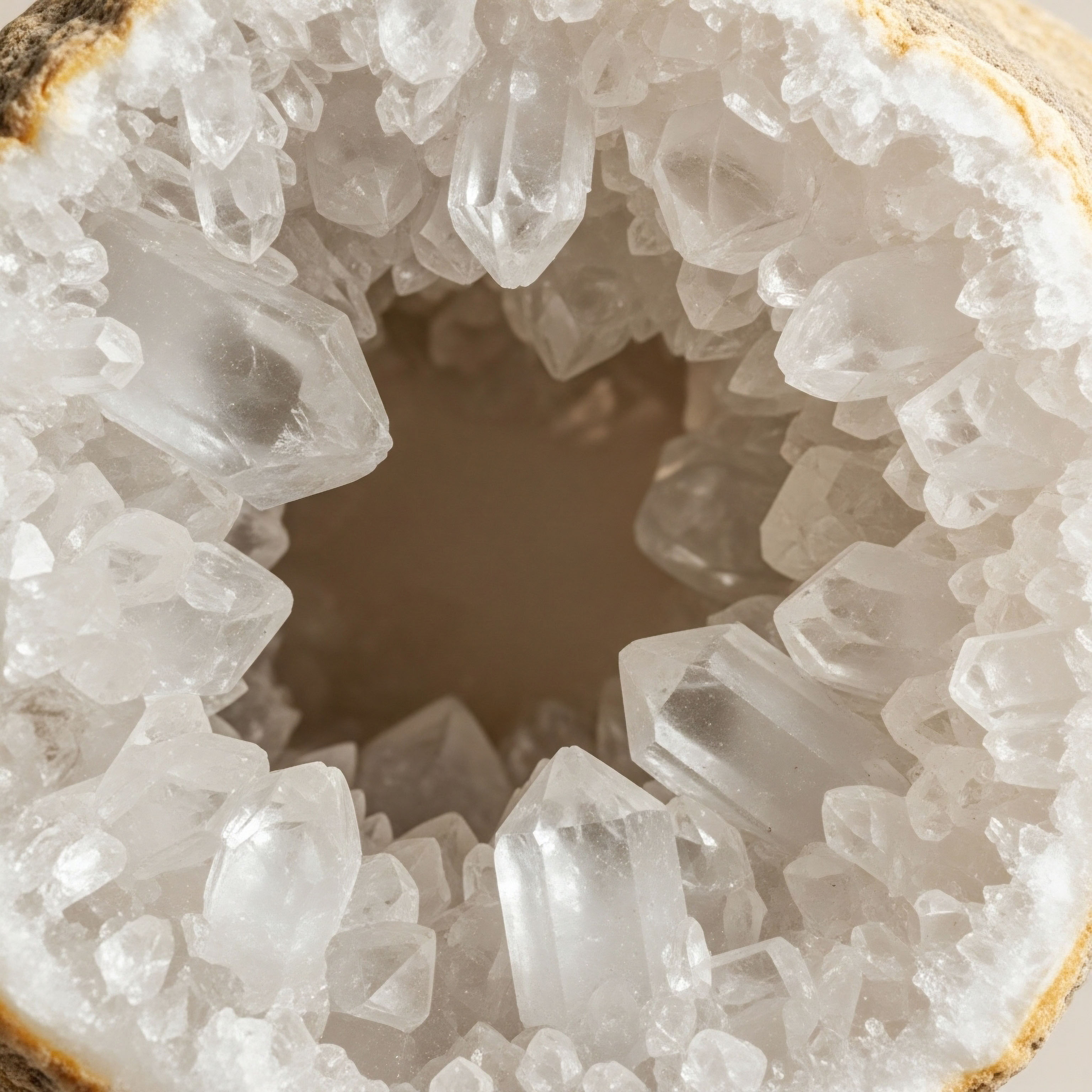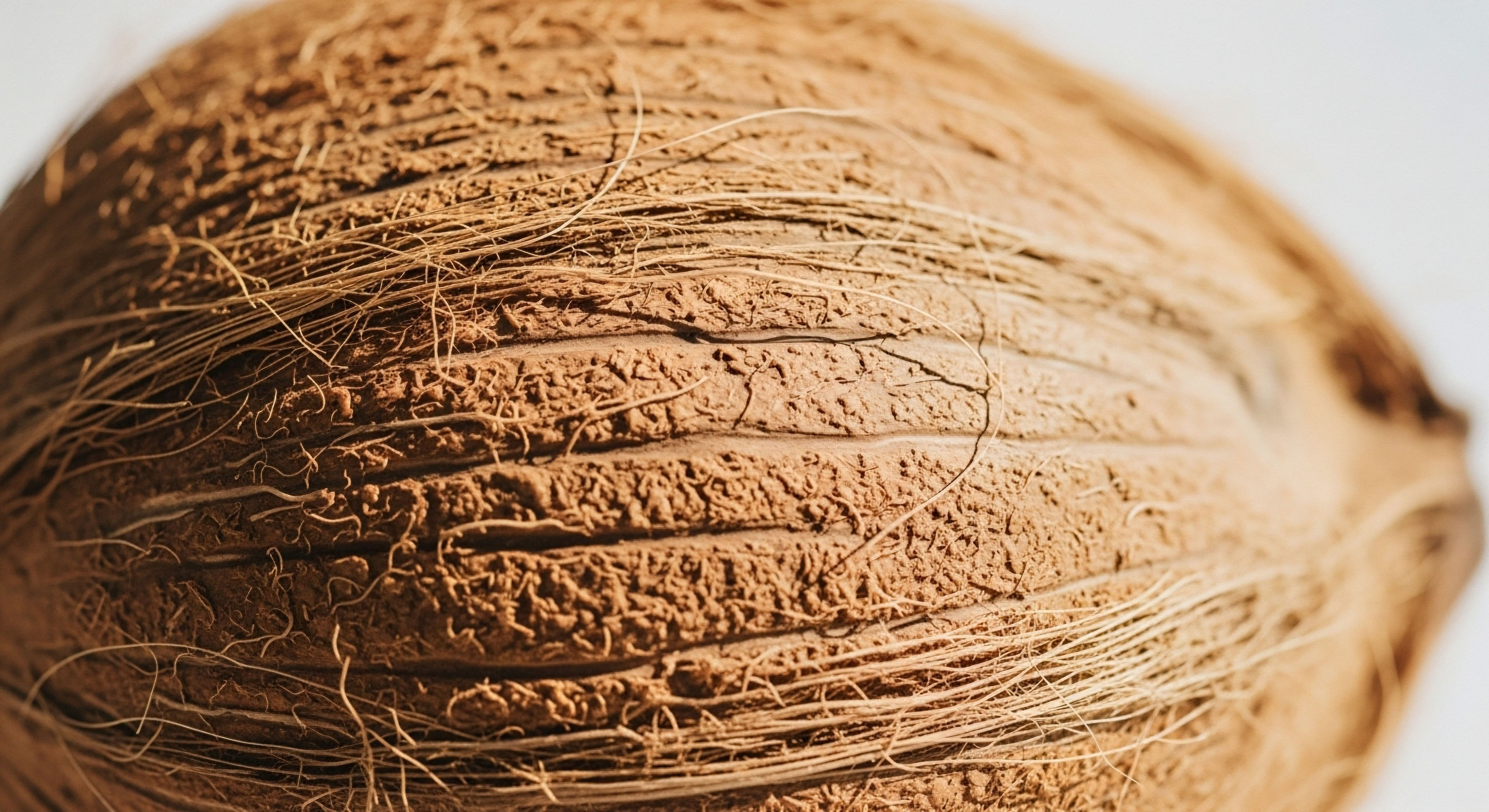

Fundamentals
You have taken a significant step. Holding the small glass vial, you are at a critical juncture in your personal health protocol. Inside rests a lyophilized powder, a potent biological signal designed to communicate with your body’s intricate systems. The process you are about to undertake, reconstitution, is the moment this signal is brought to life.
Your actions in the next few minutes will determine the clarity and strength of that message. The entire purpose of this protocol is to deliver a precise molecular key to a specific cellular lock. The environment you create during reconstitution dictates how perfectly that key is forged.
Reconstitution is the process of returning a dried, preserved substance to its liquid state. In the context of peptide therapies, this means carefully dissolving the lyophilized powder in a sterile solvent. This action transforms the dormant peptide into a biologically active solution ready for administration.
The integrity of the peptide’s structure, a delicate three-dimensional architecture, is paramount. This shape is what allows it to bind to its target receptors and initiate a specific physiological response, whether that is signaling for tissue repair, modulating hormone production, or influencing metabolic pathways. Any deviation in this structure, caused by an environmental stressor, can render the peptide less effective or entirely inert.
The objective of reconstitution is the precise activation of a dormant biological signal while preserving its structural integrity.

The Primary Environmental Factors
Four primary environmental factors stand as gatekeepers to a peptide’s bioavailability during this critical process. Understanding and controlling them is fundamental to ensuring the full potential of the therapy is delivered to your system. These elements are temperature, the pH of the solution, exposure to oxygen, and the application of mechanical force.

Temperature a Key Regulator
Temperature acts as a powerful catalyst for chemical reactions, including those that degrade peptides. While lyophilized peptides are relatively stable, once reconstituted, they become vulnerable. Excessive heat can accelerate hydrolysis and oxidation, effectively dismantling the peptide’s structure. Conversely, the process of freezing and thawing a reconstituted solution can also cause damage.
The formation of ice crystals can create mechanical stress on the delicate peptide chains, leading to aggregation and a loss of function. This is why protocols emphasize storing reconstituted peptides at a stable, refrigerated temperature and avoiding repeated freeze-thaw cycles.

Solution Ph the Chemical Environment
The pH of the solvent creates the chemical landscape in which the peptide is revived. Every peptide has an optimal pH range for stability. Outside of this range, its amino acid side chains can gain or lose protons, altering the peptide’s net electrical charge.
This change disrupts the intramolecular forces that maintain its correct three-dimensional fold. Such disruption can expose hydrophobic regions of the peptide, causing molecules to clump together, a process known as aggregation. This renders the peptide insoluble and unable to interact with its cellular targets. The choice of solvent, whether it is bacteriostatic water or a dilute acidic solution, is made specifically to create a pH environment that safeguards the peptide’s structure.

Oxygen and Light Exposure
Certain amino acids, particularly methionine and cysteine, are highly susceptible to oxidation. Exposure to atmospheric oxygen during reconstitution and storage can trigger chemical reactions that alter these residues. The oxidation of cysteine, for instance, can prevent the formation of correct disulfide bonds, which are critical structural staples for many peptides.
This oxidative damage can irreversibly alter the peptide’s shape and function. Similarly, exposure to ultraviolet light can provide the energy needed to initiate damaging photochemical reactions. For this reason, peptides are often supplied in amber or opaque vials, and care should be taken to minimize their exposure to both air and direct light during handling.

Mechanical Stress the Physical Force
The physical force applied during reconstitution is a frequently underestimated factor. Vigorous shaking or agitation introduces shear stress and creates an air-liquid interface that can denature proteins and peptides. This process is similar to how whipping egg whites turns them from a clear liquid into a white solid foam; the mechanical force unfolds the proteins.
When reconstituting a peptide, the goal is gentle dissolution. This is achieved by allowing the solvent to run down the side of the vial and then gently swirling the vial. This technique minimizes physical stress, protecting the peptide’s fragile structure from being torn apart before it can even begin its work in the body.


Intermediate
Advancing beyond foundational knowledge requires a deeper examination of the specific mechanisms and protocols that govern peptide stability. The ‘why’ behind each step in a reconstitution protocol is rooted in the biochemical properties of the peptides themselves. Understanding these principles allows for a more precise and effective application of these powerful therapeutic agents, ensuring that what is administered is what the body is intended to receive.

How Does the Choice of Solvent Impact Peptide Potency
The solvent, or diluent, is the medium that carries the peptide. Its composition is a critical factor in maintaining the peptide’s bioavailability. The most common solvents used in clinical practice each have a specific purpose tied to peptide stability and safe administration.
- Bacteriostatic Water ∞ This is sterile water containing 0.9% benzyl alcohol. The benzyl alcohol acts as a preservative, inhibiting microbial growth. This makes bacteriostatic water the standard choice for multi-dose vials, as it allows for repeated withdrawals while maintaining sterility. The presence of benzyl alcohol has a minimal effect on the pH and is compatible with a wide range of peptides used in hormonal and metabolic health protocols, such as BPC-157, Sermorelin, and Ipamorelin.
- Sterile Water ∞ This is pure, sterile water with no preservatives. It is intended for single-use applications only. Once the vial’s septum is punctured, any remaining solution lacks protection from microbial contamination. It is a suitable solvent, but its use requires strict aseptic technique and immediate disposal of any unused portion.
- Acetic Acid Solution ∞ For certain peptides that are highly hydrophobic or have specific stability requirements, a dilute solution of acetic acid (e.g. 0.1%) may be required. The acidic pH helps to solubilize these peptides and can prevent aggregation by ensuring the molecule carries a net positive charge. This is more common in a research setting but is occasionally required for specific therapeutic peptides that are unstable at a neutral pH.
Before reconstitution, both the peptide vial and the solvent should be allowed to come to room temperature. Introducing a cold solvent to the lyophilized powder can shock the system, potentially affecting solubility and stability. This simple step ensures a smooth transition from a solid to a liquid state.
The selected solvent creates the immediate chemical environment that must support the peptide’s structure and sterility.

The Science of Gentle Reconstitution
The physical technique of reconstitution is designed to minimize two primary forms of stress ∞ shear stress and interfacial stress. Vigorous shaking introduces both, leading to irreversible aggregation and a loss of bioactivity. A proper, gentle technique is a clinical necessity.
- Preparation ∞ The workspace is prepared to be clean and sterile. The flip-off caps are removed from both the peptide vial and the solvent vial, and the rubber stoppers are cleansed with an alcohol swab.
- Solvent Withdrawal ∞ A sterile syringe is used to draw the prescribed volume of solvent. The volume is determined by the desired final concentration of the peptide solution.
- Slow Injection ∞ The needle is inserted through the center of the peptide vial’s stopper. The plunger is depressed slowly, aiming the stream of solvent against the side of the glass vial. The solvent should run gently down the wall of the vial to the powder at the bottom. This technique avoids direct, forceful impact on the peptide powder.
- Gentle Dissolution ∞ The vial is gently swirled or rolled between the hands. This creates a gentle current within the solvent that dissolves the powder without introducing significant mechanical stress. The solution should become clear, indicating that the peptide has fully dissolved.
This methodical approach ensures that the transition from a stable, lyophilized state to a bioactive, liquid state occurs with minimal structural damage. It is a practical application of biochemical principles designed to preserve the therapeutic potential of the peptide.

Temperature Storage and the Freeze Thaw Cycle
The admonition to avoid repeated freeze-thaw cycles is based on the physical chemistry of water and its interaction with dissolved peptides. When a peptide solution freezes, ice crystals form. These crystals have sharp, geometric structures that can physically shear and denature the peptide molecules. Furthermore, as pure water crystallizes, the dissolved solutes, including the peptides and any salts, become highly concentrated in the remaining unfrozen liquid. This state of high concentration can itself force peptide molecules together, promoting aggregation.
Upon thawing, some of this aggregation may be irreversible. Each subsequent freeze-thaw cycle compounds the damage. For this reason, the standard protocol for many peptide therapies involves reconstituting a vial and storing it under refrigeration (typically 2-8°C), where it remains stable for a designated period. If a larger quantity is reconstituted for longer-term use, it is often aliquoted into smaller, single-use volumes that can be frozen once and thawed once, just before administration.
The table below outlines general storage guidelines, though specific recommendations for each peptide should always be followed.
| Peptide State | Short-Term Storage | Long-Term Storage | Key Consideration |
|---|---|---|---|
| Lyophilized Powder | Room Temperature (days to weeks) | -20°C or lower (months to years) | Protect from moisture and light. |
| Reconstituted Solution | 2-8°C (weeks) | -20°C (months, single freeze) | Avoid repeated freeze-thaw cycles. |


Academic
A comprehensive understanding of peptide bioavailability requires an academic appreciation of the specific chemical degradation pathways and the biophysical principles of aggregation. The environmental factors discussed previously are macroscopic variables that influence these microscopic events. From a systems-biology perspective, a failure to control the reconstitution environment can lead to the administration of a solution containing a heterogeneous mix of native peptides, inactive analogues, and aggregates, resulting in unpredictable and suboptimal clinical outcomes.

What Are the Primary Mechanisms of Peptide Degradation
The loss of a peptide’s biological activity during and after reconstitution is primarily attributable to two classes of processes ∞ chemical degradation, which alters the covalent structure of the peptide, and physical degradation, which involves changes in the peptide’s higher-order structure, most notably aggregation.

Chemical Degradation Pathways
Several chemical reactions can modify amino acid residues, altering the peptide’s structure and function. The rates of these reactions are highly dependent on pH, temperature, and the presence of oxidizing agents.
- Deamidation ∞ This is a common degradation pathway for peptides containing asparagine (Asn) and glutamine (Gln) residues. The side chain amide group is hydrolyzed, converting the residue to aspartic acid or glutamic acid, respectively. This introduces a negative charge, which can disrupt electrostatic interactions critical for proper folding and receptor binding. The reaction proceeds via a cyclic imide intermediate, and is significantly accelerated at neutral to alkaline pH. Sequences such as Asn-Gly are particularly susceptible.
- Hydrolysis ∞ The peptide bond itself can be cleaved through hydrolysis. This reaction is most likely to occur at aspartic acid (Asp) residues, especially in Asp-Pro and Asp-Gly sequences. The process involves the formation of a cyclic anhydride intermediate that, upon hydrolysis, can either regenerate the original peptide or cleave the peptide backbone. This fragmentation results in a complete loss of activity.
- Oxidation ∞ Methionine (Met) and Cysteine (Cys) are the most readily oxidized amino acid residues. Methionine can be oxidized to form methionine sulfoxide, a modification that can decrease the peptide’s binding affinity for its receptor. Cysteine oxidation can lead to the formation of incorrect intramolecular or intermolecular disulfide bonds, resulting in misfolded and often aggregated protein structures. This process is accelerated by exposure to atmospheric oxygen, trace metal ions, and higher pH levels.

Can Reconstitution Errors Invalidate Clinical Lab Results
Yes, errors during the handling and reconstitution of peptide standards are a significant source of variability in analytical assays. In a clinical or research setting, the accurate quantification of a peptide therapeutic relies on comparing the sample to a reference standard of known concentration.
If the reference standard is improperly reconstituted, leading to degradation or aggregation, the resulting standard curve will be inaccurate. This can lead to an overestimation or underestimation of the peptide concentration in the actual therapeutic product. Factors like hygroscopicity (the tendency to absorb moisture from the air) and static charge can also make the initial weighing of the lyophilized powder inaccurate, further compounding dosing errors. This underscores the necessity for rigorous, standardized procedures in both clinical application and quality control.
The chemical stability of a peptide is a function of its amino acid sequence and its immediate chemical environment.

Physical Degradation Aggregation Kinetics
Aggregation is the process by which peptide monomers associate to form larger, often insoluble, complexes. This is a major concern for peptide therapeutics, as aggregates can be immunogenic and lack biological activity. The formation of structured aggregates, known as amyloid fibrils, often follows a nucleation-polymerization mechanism.
This process is characterized by a lag phase, during which aggregation-prone nuclei are formed, followed by a rapid growth phase where monomers are added to the growing fibril. Environmental factors have a profound impact on this process.
The table below summarizes how various factors influence the kinetics of peptide aggregation.
| Environmental Factor | Influence on Aggregation Kinetics | Underlying Mechanism |
|---|---|---|
| Concentration | Higher concentration shortens the lag phase and increases aggregation rate. | Increases the probability of intermolecular collisions required for nucleation. |
| Temperature | Increased temperature generally accelerates aggregation up to the point of denaturation. | Provides the kinetic energy to overcome conformational energy barriers for unfolding and association. |
| pH | Aggregation is often maximal near the peptide’s isoelectric point (pI). | At the pI, the net charge of the peptide is zero, minimizing electrostatic repulsion between monomers. |
| Mechanical Agitation | Significantly shortens the lag phase and accelerates aggregation. | Introduces energy, increases molecular collisions, and creates air-water interfaces that promote unfolding. |
Understanding these mechanisms reveals that proper reconstitution is an exercise in kinetic control. The goal is to keep the peptide in its stable, monomeric, and biologically active state by creating an environment that disfavors the chemical and physical pathways leading to degradation. This requires a deep respect for the molecule’s inherent properties and a meticulous adherence to protocols designed to protect them.

References
- Zapadka, K. L. et al. “Factors affecting the physical stability (aggregation) of peptide therapeutics.” Interface Focus, vol. 7, no. 5, 2017, p. 20170030.
- “Peptide Stability and Potential Degradation Pathways.” Technical Bulletin, Sigma-Aldrich Co. LLC.
- Mutt, V. and J. E. Jorpes. “Procedure for the isolation of secretin.” Methods in Hormone Research, vol. 2, 1968, pp. 569-588.
- Manning, M. C. et al. “Stability of protein pharmaceuticals ∞ an update.” Pharmaceutical research, vol. 27, no. 4, 2010, pp. 544-575.
- “Identifying Trending Issues in Assay of Peptide Therapeutics During Stability Study.” American Journal of Biomedical Science and Research, vol. 22, no. 2, 2024.
- “Correct Peptide Reconstitution.” Particle Peptides, technical documentation.
- Carpenter, J. F. et al. “Rational design of stable lyophilized protein formulations ∞ some practical advice.” Pharmaceutical research, vol. 14, no. 8, 1997, pp. 969-975.
- Kreilgaard, L. et al. “Effect of temperature and pH on the stability of growth hormone in aqueous solution.” Journal of pharmaceutical sciences, vol. 88, no. 4, 1999, pp. 437-443.

Reflection
You now possess a deeper awareness of the delicate science that underpins your protocol. The knowledge of how temperature, pH, and even the simple act of swirling a vial can influence a therapeutic outcome changes your relationship with the process. It transforms a routine task into a deliberate act of precision.
Each step, from cleansing the stopper to the gentle introduction of the solvent, becomes a conscious effort to protect the potential held within that vial. This understanding is the foundation of true partnership in your own health journey.

Your Role in Bioavailability
Consider the variables within your control. The environment you create for reconstitution is not external to the therapy; it is an integral part of it. How does this knowledge reframe your approach to your own protocols? Recognizing the fragility of these complex molecules instills a respect for the precision required to steward them effectively from the pharmacy to your cells.
The power of these therapies is unlocked not just by their administration, but by the careful, informed handling that precedes it. Your personal commitment to this precision is a direct investment in the outcome you seek.



